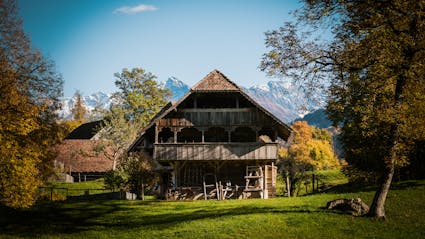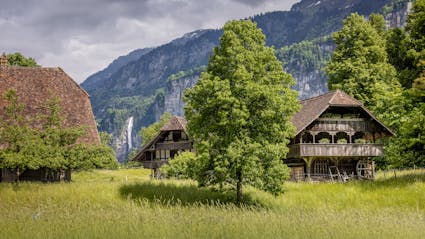332 – Granary from Ostermundigen Berne, 1760
The main house of the farmstead burned down in 1797. The granary remained unscathed, thanks to the distance to the main house.

Almost burned down
Grain storage buildings are not isolated objects, but are part and parcel of a unit: a farmstead with several associated buildings. That was also the case on the “im Eichenacker” farm. The main house of the farmstead burned down in 1797 – it was the predecessor of the farmhouse from Ostermundigen (331). The granary remained untouched due to its distance from the main house.

Magnificent as the main house
At the original location the grain storage building had a cellar with a barrel vault ceiling. When re-erecting the building at Ballenberg in 1979, we had to forego the vault for financial reasons. In all other respects the magnificent granary remains as originally built: two full stories with the original silo bins on the lower floor. In the course of time the granary had been rebuilt as a home for the elders. When re-erecting it in the Open Air-Museum we removed the living quarters and restored it to its original state.

Finesse in the Details
Surrounding galleries form arcades and reinforce the impressive character. The massive gable with its quarter-hips contributes to it as well. Further finesses appear in details: the woodwork is decorative in many places, the cellar has a window framed in sandstone, the boards of the gallery railings carry fretwork and show evidence of once having been painted.
The Farmer’s Treasury
A granary is not just any building: it holds the grain. If the contents are lost, there will be neither bread nor mash, just hunger. Granaries were never located close to the farmhouse to avoid catching fire in the event of a housefire. They were also never located downwind of the farmhouse – otherwise the fire might spread in spite of the distance. The wind need only carry a few burning shingles to start things going … Neither was the granary located too far from the main house, but was kept within sight, well in the direct view of the farm family from the parlour. Such farmers’ treasuries were particularly attractive to thieves, since the farmers kept not only their grain there but also all kinds of valuables, textiles, documents and other costly goods.
Ballenberg
Swiss Open-Air Museum
Museumsstrasse 100
CH-3858 Hofstetten bei Brienz
Company holidays
24 December 2025 to 11 January 2026
Opening hours Administration
3 November 2025 to 8 April 2026
From Monday to Friday
8.30 am to 11.30 am
1.30 pm to 4.30 pm
Opening hours
9 April to 1 November 2026
10 am to 5 pm daily